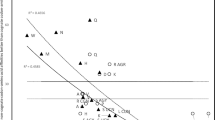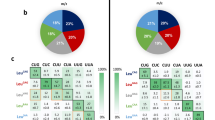Abstract
The origin of the genetic code is a central open problem regarding the early evolution of life. Here, we consider two undeveloped but important aspects of possible scenarios for the evolutionary pathway of the translation machinery: the role of unassigned codons in early stages of the code and the incorporation of tRNA anticodon modifications. As the first codons started to encode amino acids, the translation machinery likely was faced with a large number of unassigned codons. Current molecular scenarios for the evolution of the code usually assume the very rapid assignment of all codons before all 20 amino acids became encoded. We show that the phenomenon of nonsense suppression as observed in current organisms allows for a scenario in which many unassigned codons persisted throughout most of the evolutionary development of the code. In addition, we demonstrate that incorporation of anticodon modifications at a late stage is feasible. The wobble rules allow a set of 20 tRNAs fully lacking anticodon modifications to encode all 20 canonical amino acids. These observations have implications for the biochemical plausibility of early stages in the evolution of the genetic code predating tRNA anticodon modifications and allow for effective translation by a relatively small and simple early tRNA set.




Similar content being viewed by others
References
Agris PF, Vendeix FAP, Graham WD (2007) tRNA’s wobble decoding of the genome: 40 years of modification. J Mol Biol 366:1–13
Akashi H (2001) Gene expression and molecular evolution. Curr Opin Gen Dev 11:660–666
Beier H, Grimm M (2001) Misreading of termination codons in eukaryotes by natural nonsense suppressor tRNAs. Nucleic Acids Res 29:4767–4782
Brochier C, Forterre P, Gribaldo S (2004) Archaeal phylogeny based on proteins of the transcription and translation machineries: tackling the Methanopyrus kandleri paradox. Genome Biol 5:R17
Brooks DJ, Fresco JR, Singh M (2004) A novel method for estimating ancestral amino acid composition and its application to proteins of the Last Universal Ancestor. Bioinformatics 20:2251–2257
Chabelskaya S, Kiktev D, Philippe M, Inge-Vechtomov, Zhouravleva G (2004) Nonsense mutations in the essential gene SUP35 of Saccharomyces cerevisiae are non-lethal. Mol Genet Genomics 272:297–307
Crick FHC (1966) Codon-anticodon pairing: the wobble hypothesis. J Mol Biol 19:548–555
Crick FHC (1968) The origin of the genetic code. J Mol Biol 38:367–379
Di Giulio M (2006) The non-monophyletic origin of the tRNA molecule and the origin of genes only after the evolutionary stage of the Last Universal Common Ancestor (LUCA). J Theor Biol 240:343–352
Di Giulio M (2008) An extension of the coevolution theory of the origin of the genetic code. Biol Direct 3:37
Doronina VA, Brown JD (2006) When nonsense makes sense and vice versa: noncanonical decoding events at stop codons in eukaryotes. Mol Biol 40:654–663
Eigen M, Schuster P (1977) The hypercycle, a principle of natural self-organization Part A: emergence of the hypercycle. Naturwissenschaften 64:541–565
Fitch WM, Upper K (1987) The phylogeny of tRNA sequences provides evidence for ambiguity reduction in the origin of the genetic code. Cold Spring Harb Symp Quant Biol 52:759–767
Fournier GP, Gogarten JP (2010) Rooting the ribosomal tree of life. Mol Biol Evol 27:1792–1801
Francis BR (2011) An alternative to the RNA world hypothesis. Trends Evol Biol 3:e2
Fujishima K, Sugahara J, Kikuta K, Hirano R, Sato A, Tomita M, Kanai A (2009) Tri-split tRNA is a transfer RNA made from 3 transcripts that provides insight into the evolution of fragmented tRNAs in archaea. Proc Natl Acad Sci USA 106:2683–2687
Grosjean H, de Crécy-Lagard V, Marck C (2010) Deciphering synonymous codons in the three domains of life: co-evolution with specific tRNA modification enzymes. FEBS Lett 584:252–264
Hanyu N, Kuchino Y, Susumu N, Beier H (1986) Dramatic events in ciliate evolution: alteration of UAA and UAG termination codons to glutamine codons due to anticodon mutations in two Tetrahymena tRNAsGln. EMBO J 5:1307–1311
Higgs PG (2009) A four-column theory for the origin of the genetic code: tracing the evolutionary pathways that gave rise to an optimized code. Biol Direct 4:16
Ikehara K (2002) Origins of gene, genetic code, protein and life: comprehensive view of life systems from a GNC-SNS primitive genetic code hypothesis. J Biosci 27:165–186
Ikeuchi Y, Kimura S, Numata T, Nakamura D, Yokogawa T, Ogata T, Wada T, Suzuki T, Suzuki T (2010) Agmatine-conjugated cytidine in a tRNA anticodon is essential for AUA decoding in archaea. Nat Chem Biol 6:277–282
Johansson MJ, Esberg A, Huang B, Bjork GR, Bystrom AS (2008) Eukaryotic wobble uridine modifications promote a functionally redundant decoding system. Mol Cell Biol 28:3301–3312
Jordan IK, Kondrashov FA, Adzhubei IA, Wolf YI, Koonin EV, Kondrashov AS, Sunyaev S (2005) A universal trend of amino acid gain and loss in protein evolution. Nature 433:633–638
Kano A, Andachi Y, Ohama T, Osawa S (1993) Unassigned or nonsense codons in Micrococcus luteus. J Mol Biol 230:51–56
Kavran JM, Gundllapalli S, O’Donoghue P, Englert M, Söll D, Steitz TA (2007) Structure of pyrrolysyl-tRNA synthetase, an archaeal enzyme for genetic code innovation. Proc Natl Acad Sci USA 104:11268–11273
Keeling PJ, Doolittle WF (1996) A non-canonical genetic code in an early diverging eukaryotic lineage. EMBO J 15:2285–2290
Kramer EB, Farabaugh PJ (2007) The frequency of translational misreading errors in E. coli is largely determined by tRNA competition. RNA 13:87–96
Lagerkvist U (1978) “Two out of three”: an alternative method for codon reading. Proc Natl Acad Sci USA 75:1759–1762
Lao NT, Maloney AP, Atkins JF, Kavanagh TA (2009) Versatile dual reporter gene systems for investigating stop codon readthrough in plants. PLoS ONE 4:e7354
Lehman N, Jukes TH (1988) Genetic code development by stop codon takeover. J Theoret Biol 135:203–214
Lehmann J, Libchaber A (2008) Degeneracy of the genetic code and stability of the base pair at the second position of the anticodon. RNA 14:1264–1269
Longstaff DG, Blight SK, Zhang L, Green-Church KB, Krzycki JA (2007) In vivo contextual requirements for UAG translation as pyrrolysine. Mol Microbiol 63:229–241
Lozupone CA, Knight RD, Landweber LF (2001) The molecular basis of nuclear genetic code change in ciliates. Curr Biol 11:65–74
Mandal D, Kohrer C, Su D, Russell SP, Krivos K, Castleberry CM, Blum P, Limbach PA, Söll D, RajBhandary UL (2010) Agmatidine, a modified cytidine in the anticodon of archaeal tRNA(Ile), base pairs with adenosine but not with guanosine. Proc Natl Acad Sci USA 107:2872–2877
Meyer F, Schmidt HJ, Plumper E, Hasilik A, Mersmann G, Meyer HE, Engström A, Heckmann K (1991) UGA is translated as cysteine in pheromone 3 of Euplotes octocarinatus. Proc Natl Acad Sci USA 88:3758–3761
Muramatsu T, Nishikawa K, Nemoto F, Kuchino Y, Nishimura S, Miyazawa T, Yokoyama S (1988) Codon and amino acid specificities of a transfer RNA are both converted by a single post-transcriptional modification. Nature 336:179–181
Murina OA, Moskalenko SE, Zhouravleva GA (2010) Overexpression of genes encoding tRNATyr and tRNAGln increases the viability of Saccharomyces cerevisiae strains with nonsense mutations in the SUP45 gene. Mol Biol 44:268–276
Numata T, Ikeuchi Y, Fukai S, Suzuki T, Nureki O (2006) Snapshots of tRNA sulphuration via an adenylated intermediate. Nature 442:419–424
Oba T, Andachi Y, Muto A, Osawa S (1991) CGG: An unassigned or nonsense codon in Mycoplasma capricolum. Proc Natl Acad Sci USA 88:921–925
Osawa S, Jukes TH, Watanabe K, Muto A (1992) Recent evidence for evolution of the genetic code. Microbiol Rev 56:229–264
Pezo V, Metzgar D, Hendrickson TL, Waas WF, Hazebroucl S, Döring V, Marlière P, Schimmel P, de Crécy-Lagard V (2004) Artificially ambiguous genetic code confers growth yield advantage. Proc Natl Acad Sci USA 101:8593–8597
Phizicky EM, Hopper AK (2010) tRNA biology charges to the front. Genes Dev 24:1832–1860
Ran W, Higgs PG (2010) The influence of anticodon-codon interactions and modified bases on codon usage bias in bacteria. Mol Biol Evol 27:2129–2140
Randau L, Söll D (2008) Transfer RNA genes in pieces. EMBO Rep 9:623–628
Rodin AS, Szatmáry E, Rodin SN (2011) On origin of genetic code and tRNA before translation. Biol Direct 6:14
Rogalski M, Karcher D, Bock R (2008) Superwobbling facilitates translation with reduced tRNA sets. Nat Struct Biol 15:192–198
Santos MAS, Gomes AC, Santos MC, Carreto LC, Moura GR (2011) The genetic code of the fungal CTG clade. C R Biol 334:607–611
Schneider SU, Leible MB, Yang XP (1989) Strong homology between the small subunit of ribulose-1,5-bisphosphate carboxylase/oxygenase of two species of Acetabularia and the occurrence of unusual codon usage. Mol Gen Genet 218:445–452
Sella G, Ardell DH (2006) The coevolution of genes and genetic codes: Crick’s Frozen Accident revisited. J Mol Evol 63:297–313
Sengupta S, Yang X, Higgs PG (2007) The mechanisms of codon reassignments in mitochondrial genetic codes. J Mol Evol 64:662–688
Shaul S, Berel D, Benjamini Y, Graur D (2010) Revisiting the operational code for amino acids: ensemble attributes and their implications. RNA 16:141–153
Sonneborn TM (1965) Degeneracy of the genetic code: extent, nature, and genetic implications. In: Bryson V, Vogel HJ (eds) Evolving genes and proteins. Academic Press, New York, pp 377–397
Speyer JF, Lengyel P, Basilio C, Wahba AJ, Gardner RS, Ochoa S (1963) Synthetic polynucleotides and the amino acid code. Cold Spring Harb Symp Quant Biol 28:559–567
Takai K, Yokoyama S (2003) Roles of 5-substituents of tRNA wobble uridines in the recognition of purine-ending codons. Nucleic Acids Res 31:6383–6391
Tong KL, Wong JT (2004) Anticodon and wobble evolution. Gene 333:169–177
Ussery DW, Hallin PF, Lagesen K, Wassenaar TM (2004) Genome Update: tRNAs in sequenced microbial genomes. Microbiology 150:1603–1606
Woese CR (1965) On the evolution of the genetic code. Proc Natl Acad Sci USA 54:1546–1552
Woese CR, Dugre DH, Saxinger WC, Dugre SA (1966) The molecular basis for the genetic code. Proc Natl Acad Sci USA 55:966–974
Woese CR, Olsen GJ, Ibba M, Söll D (2000) Aminoacyl-tRNA synthetases, the genetic code, and the evolutionary process. Microb Mol Biol Rev 64:202–236
Wong JT (1975) A co-evolution theory of the genetic code. Proc Natl Acad Sci USA 72:1909–1912
Wong JT (2005) Coevolution theory of the genetic code at age thirty. BioEssays 27:416–425
Wong JT, Chen J, Mat WK, Ng SK, Xue H (2007) Polyphasic evidence delineating the root of life and roots of biological domains. Gene 403:39–52
Yamao F, Muto A, Kawauchi Y, Iwami M, Iwagami S, Azumi Y, Osawa S (1985) UGA is read as tryptophan in Mycoplasma capricolum. Proc Natl Acad Sci USA 82:2306–2309
Yarus M, Caporaso JG, Knight R (2005) Origins of the genetic code: the escaped triplet theory. Ann Rev Biochem 74:179–198
Acknowledgments
The authors gratefully acknowledge the large improvements of the manuscript based on comments of several anonymous referees. PvdG also gratefully acknowledges stimulating discussions with Dave Speijer (University of Amsterdam and Academic Medical Center) and Harry Buhrman (University of Amsterdam and Centrum Wiskunde & Informatica). This study was partly supported by Vici grant 639-023-302 from the Netherlands Organization for Scientific Research (NWO).
Author information
Authors and Affiliations
Corresponding author
Rights and permissions
About this article
Cite this article
van der Gulik, P.T.S., Hoff, W.D. Unassigned Codons, Nonsense Suppression, and Anticodon Modifications in the Evolution of the Genetic Code. J Mol Evol 73, 59–69 (2011). https://doi.org/10.1007/s00239-011-9470-3
Received:
Accepted:
Published:
Issue Date:
DOI: https://doi.org/10.1007/s00239-011-9470-3




